
A new method for the simulation and visualization of NC milling processes
has been developed. This approach is the first to take locally varying
material properties like density or color into account. The prototype implementation
allows a real time animated display of the milling process even on low-end
PCs.
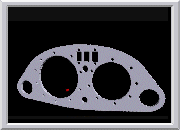 This is one of the first images created with our new method. The geometry
of the workpiece has been derived from a scanned photograph of the instrument
panel of a Honda Fireblade motorbike. The small red object in the left
one of the two big holes is the cutting tool.
This is one of the first images created with our new method. The geometry
of the workpiece has been derived from a scanned photograph of the instrument
panel of a Honda Fireblade motorbike. The small red object in the left
one of the two big holes is the cutting tool.
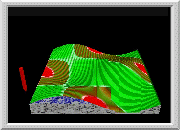 In this image of a free form surface the milling error has been color encoded.
Parts of the workpiece, where there is still too much material (undercutting)
are shaded in green, whereas parts where there has already been removed
too much material (overcutting) are shaded in red.
In this image of a free form surface the milling error has been color encoded.
Parts of the workpiece, where there is still too much material (undercutting)
are shaded in green, whereas parts where there has already been removed
too much material (overcutting) are shaded in red.
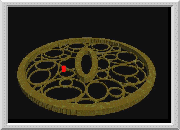 This
image shows the simulation of inhomogeneous material properties. As color
was chosen as an example property, this tsuba (which is a part of an ancient
japanese sword) has been milled from corroded bronze.
This
image shows the simulation of inhomogeneous material properties. As color
was chosen as an example property, this tsuba (which is a part of an ancient
japanese sword) has been milled from corroded bronze.
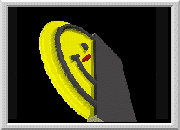 This
smiley has been milled from a compound material, consisting of two differently
colored layers of plastic.
This
smiley has been milled from a compound material, consisting of two differently
colored layers of plastic.
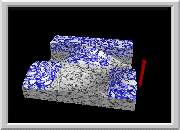 The workpiece shown in this image was rendered during the milling simulation
of a block of stock material consisting of two different kinds of marble.
The workpiece shown in this image was rendered during the milling simulation
of a block of stock material consisting of two different kinds of marble.
Andreas H. König, last update on November 1, 1997
<-back
to index
 This is one of the first images created with our new method. The geometry
of the workpiece has been derived from a scanned photograph of the instrument
panel of a Honda Fireblade motorbike. The small red object in the left
one of the two big holes is the cutting tool.
This is one of the first images created with our new method. The geometry
of the workpiece has been derived from a scanned photograph of the instrument
panel of a Honda Fireblade motorbike. The small red object in the left
one of the two big holes is the cutting tool.

 This
image shows the simulation of inhomogeneous material properties. As color
was chosen as an example property, this tsuba (which is a part of an ancient
japanese sword) has been milled from corroded bronze.
This
image shows the simulation of inhomogeneous material properties. As color
was chosen as an example property, this tsuba (which is a part of an ancient
japanese sword) has been milled from corroded bronze.
 The workpiece shown in this image was rendered during the milling simulation
of a block of stock material consisting of two different kinds of marble.
The workpiece shown in this image was rendered during the milling simulation
of a block of stock material consisting of two different kinds of marble.